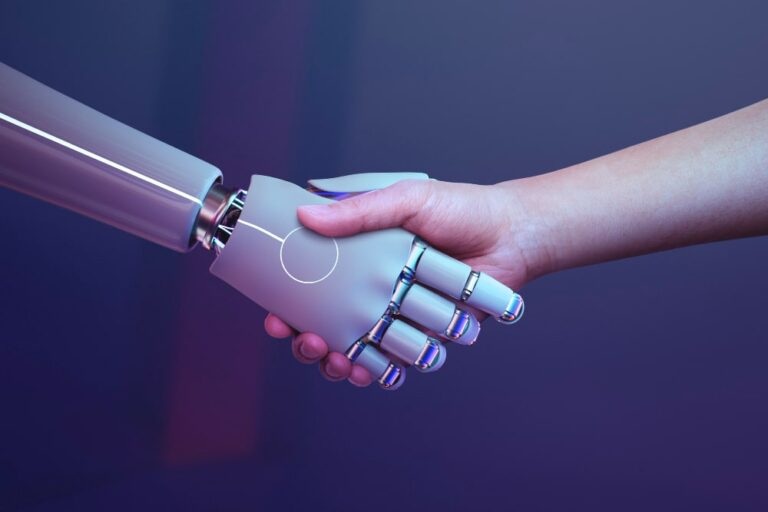In an era defined by digital innovation and technological prowess, the term “Artificial Intelligence” (AI) has transcended buzzword status to become a transformative force, quietly shaping the fabric of our daily lives. AI’s remarkable abilities have elevated it from a realm of science fiction dreams to practical applications that impact industries, from healthcare to finance, entertainment to transportation. In this exploration, we embark on a journey to demystify AI, unravel its intricacies, and understand the mechanics that enable it to work wonders.
At its core, AI represents the pinnacle of human ingenuity—a quest to create machines that can mimic human intelligence, reason like us, and, in some cases, even surpass our cognitive capabilities. It’s a journey marked by milestones and breakthroughs, each inching us closer to the realization of machines that think, learn, and make decisions autonomously. But how does AI work its magic, and what underpins its extraordinary abilities?
AI’s magic lies in its capacity to learn from data. It’s not pre-programmed for every task it performs; instead, it learns by analyzing vast amounts of data, recognizing patterns, and making predictions. This ability, often powered by a subset of AI called machine learning, is at the heart of AI’s functionality. Through machine learning, AI models can process data, identify insights, and improve their performance over time. But that’s just the tip of the iceberg. To truly grasp the workings of AI, we must delve into the intricacies of machine learning, deep learning, and their real-world applications. So, as we embark on this voyage into the realm of AI, prepare to unveil the secrets that drive the machines of tomorrow, as we uncover what AI is and how it works.
Understanding AI – An Overview:
To embark on a journey into the world of AI, it’s essential to begin with a foundational understanding of what this revolutionary field entails. At its core, Artificial Intelligence, abbreviated as AI, represents the pursuit of endowing machines with the ability to think, learn, and perform tasks that typically require human intelligence. Let’s delve deeper into this profound concept.
AI, in essence, is the quest to create intelligent agents, machines that can perceive their environment, reason about it, and take actions to achieve specific goals. However, it’s crucial to distinguish between two broad categories of AI: narrow AI, also known as weak AI, and general AI, often referred to as strong AI.
Narrow AI (Weak AI): Narrow AI refers to AI systems designed and trained for a specific task. These AI systems excel at their predefined task but lack the broad cognitive abilities associated with human intelligence. Examples of narrow AI are chatbots, image recognition algorithms, and recommendation systems. They are specialized problem solvers but do not possess general reasoning capabilities.
General AI (Strong AI): General AI, on the other hand, represents a level of AI sophistication where machines can exhibit human-like intelligence across a wide range of tasks and possess the ability to adapt to new challenges. General AI, if achieved, would have the capacity to understand, learn, and apply knowledge across various domains, similar to a human.
The primary goal of AI research and development is to bridge the gap between narrow and general AI, striving for machines that possess a broader and more versatile understanding of the world. While narrow AI has already demonstrated significant utility in various applications, the pursuit of general AI remains a grand challenge that fuels ongoing innovation and exploration in the field.
To appreciate how AI works, it’s crucial to recognize that AI systems rely heavily on data and computational power. AI models, including machine learning algorithms, ingest vast datasets, identify patterns, and use these patterns to make predictions or decisions. This process of learning from data is at the core of AI’s problem-solving abilities, enabling it to excel in tasks ranging from language translation to medical diagnosis. In our journey through AI, we’ll delve deeper into these mechanisms, unraveling the inner workings that make AI a transformative force in our modern world.
The Foundations of AI – Machine Learning:
At the heart of AI’s transformative power lies a profound concept known as machine learning. If AI is the brain, then machine learning is the neural wiring that allows it to think, adapt, and improve. To understand the foundations of AI, we must delve into the fascinating world of machine learning.
Machine learning is a subset of AI that endows machines with the ability to learn from data. Instead of being explicitly programmed for every task, machine learning models, much like students, learn by experience. They analyze vast amounts of data, identify patterns, and make predictions or decisions based on their learned knowledge.
The process begins with data. Data, in various forms—text, images, numbers—is the lifeblood of machine learning. This data is fed into algorithms, which act as the learning engines. These algorithms sift through the data, extracting features, identifying correlations, and building a model of the underlying patterns.
There are several key types of machine learning:
Supervised Learning: In supervised learning, the algorithm is trained on a labeled dataset, where the correct answers are provided. It learns to map input data to the correct output, making it suitable for tasks like image classification, language translation, and recommendation systems.
Unsupervised Learning: Unsupervised learning involves working with unlabeled data. The algorithm’s goal is to find hidden patterns or groupings within the data. Clustering and dimensionality reduction are common tasks in unsupervised learning.
Reinforcement Learning: Reinforcement learning mimics how humans learn through trial and error. An agent learns to interact with an environment to maximize a reward. It’s widely used in training autonomous systems like self-driving cars and game-playing AI.
Semi-Supervised Learning and Self-Supervised Learning: These are hybrid approaches that combine elements of both supervised and unsupervised learning. They are particularly useful when labeled data is scarce.
One of the most exciting aspects of machine learning is its ability to improve over time. As the algorithm processes more data and receives feedback, it refines its models, becoming increasingly accurate and efficient. This iterative learning process is what makes machine learning models excel in tasks ranging from natural language understanding to image recognition.
Machine learning is the driving force behind many AI applications we encounter daily, from virtual personal assistants that understand our speech to recommendation systems that suggest what to watch, read, or buy. It’s the magic that enables AI to adapt and evolve, bringing us closer to the vision of machines that can learn and reason like humans.
In our exploration of AI, we’ll continue to unravel the intricacies of machine learning, deepening our understanding of how it powers the AI revolution.
Deep Learning – The Neural Networks Revolution:
Within the vast landscape of machine learning, one paradigm has risen to prominence as the driving force behind numerous AI breakthroughs—deep learning. Deep learning is often synonymous with neural networks, a technology inspired by the architecture of the human brain. To comprehend the heart of AI’s capabilities, it’s crucial to dive into the neural networks revolution.
At the core of deep learning lies the neural network, a computational model composed of layers of interconnected nodes, often referred to as neurons. These layers are inspired by the human brain’s structure, where neurons transmit signals through complex networks. Each node in a neural network processes information, applies mathematical transformations, and passes the result to the next layer.
The term “deep” in deep learning signifies the presence of multiple hidden layers between the input and output layers. These hidden layers enable neural networks to learn and represent increasingly abstract and complex features from the input data. The depth of these networks is what gives deep learning its name and sets it apart from traditional machine learning models with fewer layers.
The power of deep learning is its ability to automatically learn hierarchical representations of data. For example, in image recognition, the initial layers might detect edges and simple shapes, while deeper layers assemble these into more complex features like eyes, noses, and faces. In natural language processing, deep learning models can automatically learn the meaning and context of words and sentences, making them proficient in tasks like language translation and sentiment analysis.
Convolutional Neural Networks (CNNs) and Recurrent Neural Networks (RNNs) are two popular types of neural networks used in deep learning. CNNs excel in tasks involving grid-like data, such as images, by using specialized layers to detect patterns. RNNs, on the other hand, are well-suited for sequential data, making them valuable for tasks like speech recognition and language modeling.
The applications of deep learning are boundless. From self-driving cars that rely on deep learning to understand their surroundings to healthcare systems that diagnose diseases from medical images, deep learning has revolutionized industries. In entertainment, deep learning powers recommendation systems that suggest what to watch or listen to next, enhancing user experiences.
One of the most famous instances of deep learning is the development of AlphaGo, an AI program that achieved superhuman performance in the complex board game Go. AlphaGo’s success showcased deep learning’s ability to tackle complex and strategic tasks.
In our journey through AI, understanding deep learning is pivotal. It forms the bedrock of numerous AI applications that enhance our lives, and it continues to push the boundaries of what machines can achieve in terms of understanding, perception, and decision-making.
AI in Action – Practical Applications:
The true measure of AI’s impact lies not in its theoretical capabilities but in its real-world applications that span diverse domains. AI’s transformative potential has come to fruition through practical implementations that enhance efficiency, accuracy, and problem-solving capabilities across various industries. Let’s explore some compelling examples of AI in action.
Healthcare and Medical Diagnosis:
- AI is revolutionizing healthcare by aiding in medical diagnosis and treatment planning. Radiologists use AI-powered image analysis to detect abnormalities in X-rays and MRIs. AI algorithms can analyze patient data to predict disease risk, enabling preventive care. Chatbots provide patient support and information.
Finance and Fraud Detection:
- In the financial sector, AI algorithms are employed for fraud detection and risk assessment. Machine learning models analyze vast transaction datasets in real-time to identify suspicious activities. Chatbots and virtual assistants assist customers with queries and financial planning.
Autonomous Vehicles and Transportation:
- The development of self-driving cars relies heavily on AI. These vehicles use sensors, cameras, and AI algorithms to perceive their surroundings, make real-time decisions, and navigate safely. AI also plays a role in optimizing traffic management and reducing congestion.
E-commerce and Personalization:
- E-commerce platforms leverage AI to enhance user experiences. Recommendation systems analyze user behavior to suggest products, increasing sales and customer satisfaction. AI-driven chatbots assist shoppers with inquiries and help streamline the buying process.
Language Translation and Natural Language Processing:
- AI has made significant strides in language-related tasks. Translation services like Google Translate use AI algorithms to provide real-time language translation. Natural language processing (NLP) powers virtual assistants like Siri and Alexa, enabling voice commands and responses.
Manufacturing and Quality Control:
- AI-driven robots and automation systems are used in manufacturing for quality control and process optimization. Computer vision algorithms inspect products for defects, ensuring high-quality production. Predictive maintenance helps prevent costly equipment breakdowns.
Education and Personalized Learning:
- AI is transforming education by providing personalized learning experiences. Adaptive learning platforms analyze student performance and tailor lessons to individual needs. Chatbots assist students with queries and homework.
Entertainment and Content Generation:
- In entertainment, AI is used for content generation and recommendation. AI algorithms can create music, art, and even write articles. Streaming platforms use AI to recommend movies, TV shows, and music based on user preferences.
Agriculture and Precision Farming:
- Agriculture benefits from AI-driven precision farming techniques. Drones equipped with AI analyze crop health and optimize irrigation. AI-powered machinery enhances crop yield and reduces resource usage.
These practical applications demonstrate AI’s versatility and its ability to address a wide range of challenges and opportunities. As AI technology continues to evolve, its impact is poised to expand further, transforming industries and shaping the way we live and work. The integration of AI into our daily lives is not a distant future; it’s a reality that is unfolding before our eyes.
The Future of AI – Advancements and Challenges:
As we stand at the crossroads of AI’s evolution, the road ahead is filled with promise and challenges. The future of AI is a horizon where groundbreaking advancements intersect with complex issues that demand our attention. Let’s peer into this future and explore what lies on the path ahead.
Advancements:
Explainable AI (XAI): One of the key advancements in AI will be the development of Explainable AI (XAI). XAI aims to demystify the decision-making processes of AI models, making them transparent and understandable to humans. This will be critical in high-stakes applications like healthcare and finance, where trust and accountability are paramount.
AI Ethics and Responsible AI: Ethical considerations will continue to gain prominence. AI developers and organizations will prioritize creating AI systems that adhere to ethical guidelines. This includes addressing bias, ensuring fairness, and protecting user privacy.
AI for Sustainability: AI will play a pivotal role in addressing global challenges such as climate change. Machine learning models will be used to optimize energy consumption, reduce waste, and enhance environmental monitoring.
AI in Healthcare Breakthroughs: AI will advance healthcare with more accurate diagnostics, drug discovery, and personalized treatment plans. AI-driven telemedicine and remote monitoring will become integral components of healthcare delivery.
Human-AI Collaboration: The future will witness a deeper integration of AI into various aspects of our lives. Human-AI collaboration will become more commonplace, with AI systems serving as virtual coworkers, assisting in decision-making, and automating routine tasks.
Challenges:
Ethical Dilemmas: As AI systems become more autonomous, ethical dilemmas will intensify. Questions surrounding AI’s role in decision-making, accountability for AI-generated outcomes, and the potential misuse of AI will require ongoing attention.
Bias and Fairness: Addressing bias in AI algorithms will remain a challenge. Developers must strive to eliminate biases in training data and algorithms to ensure fair and equitable outcomes, particularly in areas like hiring and lending.
Job Displacement: The automation of tasks by AI may lead to job displacement in certain industries. Preparing the workforce for the changing job landscape and ensuring a just transition will be crucial.
AI Regulation: Policymakers will grapple with the task of creating regulatory frameworks that strike a balance between fostering innovation and safeguarding against AI misuse. Developing international standards for AI governance will be an ongoing challenge.
AI Security: As AI systems become more integrated into critical infrastructure, securing AI against cyber threats will be paramount. Adversarial attacks, which manipulate AI systems, will necessitate robust security measures.
AI for Good vs. Harm: The dual-use nature of AI technology raises concerns about its potential for both beneficial and harmful applications. Safeguarding against AI misuse and ensuring its positive impact on society will require vigilance.
In summary, the future of AI is a dynamic landscape that holds immense potential for societal transformation. Advancements in AI will continue to drive innovation and improve our lives, but they will also demand our vigilance in addressing ethical, societal, and security challenges. As stewards of AI’s development, we must navigate this path with wisdom and responsibility to harness the full potential of AI for the benefit of humanity.




